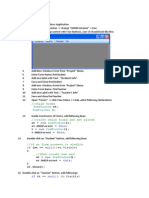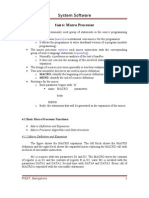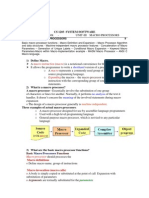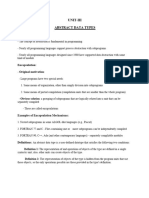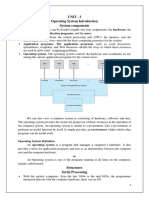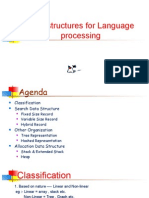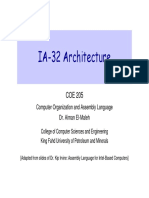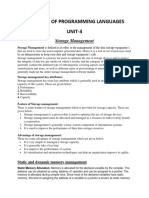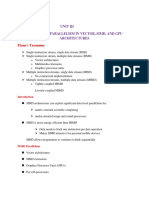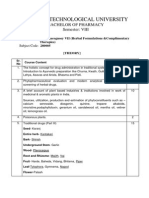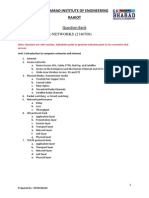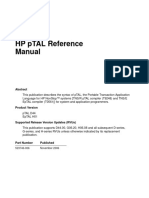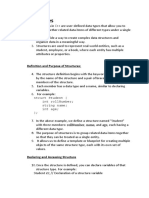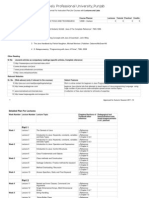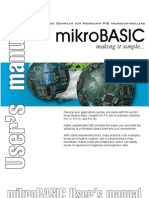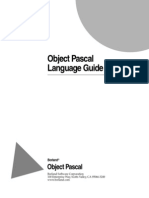M ACROS AND M ACRO P ROCESSORS
By: Nitin Birari
�INTRODUCTION
Macros are used to provide a program
generation
facility through macro expansion.
Many languages provide build-in facilities
for writing macros like PL/I, C, Ada AND
C++.
Assembly languages also provide such
facilities.
When a
language does not support
build-in
facilities for writing macros what is to be
done?
A programmer may achieve an equivalent
MACRO
Def: A macro is a unit of specification for
program generation through expansion.
A macro consists of
a name,
a set of formal parameters and
a body of code.
The use of a macro name with a set of
actual parameters is replaced by some
code generated from its body.
This is called macro expansion.
Two kinds of expansion can be identified.
�CLASSIFICATION
Lexical expansion:
OF MACROS:
Lexical expansion
implies replacement of a
character string by another
character string
during program generation.
Lexical expansion is to replace occurrences of
formal
parameters by corresponding actual parameters.
Semantic expansion:
Semantic expansion implies generation of
instructions tailored to the requirements of a
specific usage.
Semantic expansion is characterized by the fact that
different uses of a macro can lead to codes which
differ in the number, sequence and opcodes of
instructions.
Eg: Generation of type specific instructions for
�EXAMPLE
The following sequence of instructions is used to
increment the value in a memory word by a
constant.
1.
Move the value from the memory word into a
machineregister.
2.
Increment the value in the machine register.
3.
Move the new value into the memory word.
Since the instruction sequence MOVE-ADDMOVE may be used a number of times in a
program, it is convenient to define a macro
named INCR.
Using
Lexical expansion the macro call
INCR A,B,AREG can lead to the
generation
ofa MOVE- ADD-MOVE instruction sequence to
increment A by the value of B using AREG to
perform the arithmetic.
Use of Semantic expansion can enable the
�HOW
DOES MACRO DIFFER FROM
SUBROUTINE?
Macros differ from subroutines in one
fundamental respect.
Use of a macro name in the mnemonic field
of an assemblystatement
leads to
its expansion,
whereas
use of subroutine name in a call
instruction leads to its execution.
So there is difference in
Size
Execution Efficiency
Macros can be said to trade program
size for execution efficiency.
More difference would be discussed at the
�MACRO DEFINITION AND CALL
MACRO DEFINITION
A macro definition is enclosed between a macro header
statement and a macro end statement.
Macro definitions are typically located at the start of a program.
A macro definition consists of.
A macro prototype statement
One or more model statements
Macro preprocessor statements
The macro prototype statement declares the name of a
macro and the names and kinds of its parameters.
It has the following syntax
<macro name> [< formal parameter spec > [,..]]
Where <macro name> appears in the mnemonic field
of an assembly statement and
< formal parameter spec> is of the form
&<parameter name> [<parameter kind>]
Open your book and see example 5.2 on pg 133.
�MACRO CALL
A macro is called by writing
the macro name
in
the mnemonic field.
Macro call has the following syntax.
<macro name> [<actual parameter
spec>[,..]]
Where an actual parameter resembles an
operand specification in an assembly
language statement.
�EXAMPLE
MACRO and MEND are the macro header and
macro
end statements.
The prototype statement indicates that
three parameters called
MEM_VAL,
INCR_VAL and
REG exists
for the
macro.
Since
parameter
kind is
not
specified
�MACRO
INCR
MOVER
ADD
MOVEM
MEND
&MEM_VAL, &INCR_VAL, ®
®, &MEM_VAL
®, &INCR_VAL
®, &MEM_VAL
�MACRO
EXPANSION
Macro call leads to macro expansion.
During macro expansion, the macro call
statement is replaced by a sequence of
assembly statements.
How to
differentiate betw een the original
statements of a program
and the
statements resu ltin g
from m acro expansion?
Ans: Each expanded state men t is ma rk ed with a
+ preceding its label field.
Two key notions concerning macro expansion
are
A. Expansion time control flow : This determines the
order in which model statements are visited during
macro expansion.
B. Lexical substitution:
Lexical substitution is
�A. EXPANSION
TIME CONTROL FLOW
The default flow of control during macro
expansion is
sequential.
In the absence of preprocessor statements, the
model statements of a macro are visited
sequentially starting with the statement
following the macro prototype statement and
ending with the statement preceding the MEND
statement.
What can alter the flow of control during
expansion?
A preprocessor statement can alter the flow of
control during expansion such that
Conditional Expansion: some
model statements
are either never visited during expansion, or
Expansion Time Loops: are repeatedly visited during
expansion.
�ALGOTIRHM (MACRO
EXPANSION)
1. MEC:=statement number of first
statement
following the prototype stmt.
2.
While statement pointed by MEC is
not a MEND statement.
a.
If a model statement then
i. Expand the statement
ii. MEC:=MEC+1;
b.
3.
Else (i.e. a preprocessor statement)
i. MEC:= new value specified in the statement.
Exit from macro expansion.
�B. LEXICAL SUBSTITUTION
A model statement consists of 3 types of strings.
An ordinary string, which stands for itself.
The name of a formal parameter which is preceded
by the character &.
The name of a preprocessor variable, which is also
preceded by
the cha racter &.
During lexical expansion, strings of type 1 are
retained without substitution.
String of types 2 and 3 are replaced by the 'values' of the
formal parameters or preprocessor variables.
Rules for determining the value of a formal
parameter
depends on the kind of parameter:
Positional Parameter
Keyword Parameter
Default specification of parameters
Macros with mixed parameter lists
�POSITIONAL PARAMETERS
A positional formal parameter is written as
&<parameter name>,
e.g. &SAMPLE
where SAMPLE is the name of parameter.
<parameter kind> of syntax rule is omitted.
The value of a positional formal parameter
XYZ is determined
by the
rule of
positional association as follows:
Find
the ordinal position of XYZ in the list
of formal parameters in the
macro
prototype statement.
Find the actual parameter specification occupying
the same ordinal position in the list of actual
parameters in the macro call statement.
�EXAMPLE
Consider the
call: A,B,AREG
INCR following rule of
On macro INCR,
positional association, values of formal
parameters
Formal parameter
value
are:
MEM_VAL
A
INCR_VAL
Lexical expansion
of the model statements now
leads to the code
B
+ MOVER AREG,A
REG
+ ADD AREG,B
+ MOVEM AREG,A
AREG
�KEYWORD PARAMETER
For keyword parameter,
<parameter
name> is an ordinary string and
<parameter
kind> is the string =
in syntax rule.
The <actual parameter
spec> is written as
<formal parameter
name>=<ordinary string>.
Note
that the ordinal position of the
specification XYZ=ABC
in the list
of
actual parameters is immaterial.
This is very useful in situations where long
lists of parameters have to be used.
�EXAMPLE:
Following are macro call statement:
INCR_M MEM_VAL=A, INCR_VAL=B, REG=AREG
-----INCR_M INCR_VAL=B, REG=AREG, MEM_VAL=A
Both are equivalent.
Following is macro definition using
keyword parameter:
MACRO
INCR_M
&MEM_VAL=,
&INCR_VAL=,®=
MOVER
®, &MEM_VAL
ADD
®, &INCR_VAL
MOVEM
®,&MEM_VAL
MEND
�DEFAULT
SPECIFICATIONS OF
PARAMETERS
A default
value is a standard assumption
in the absenceof an explicit specificationby
the programmer.
Default
specificationof parametersis useful
insituations where a parameter has
the same value in most calls.
When the desired value is different from
the default value, the desired value can be
specified explicitly in a macro call.
The syntax for formal parameter
specification, as follows:
&<parameter name>
[<parameter kind> [<default
�EXAMPLE
The macro can be redefined to use a default
specification
INCR_D
MEM_VAL=A,
for
the parameter
REG INCR_VAL=B
INCR_D INCR_VAL=B, MEM_VAL=A
INCR_D INCR_VAL=B, MEM_VAL=A,
REG=BREG
First
two calls are equivalent but
third call overrides
the default value
for REG with the value BREG in next example.
Have a look.
MACRO
INCR_D
&MEM_VAL=, &INCR_VAL=,
®=AREG
MOVER
®, &MEM_VAL
ADD
®, &INCR_VAL
MOVEM
®, &MEM_VAL
�MACROS
WITH MIXED PARAMETER LISTS
A macro may be defined to use both
positional
and keyword parameters.
Insuch
a case, all positional parameters
must precede
all keyword parameters.
example in the macro call
SUMUP
A, B, G=20,
H=X
A, B are positional parameters while G, H are
keyword parameters.
Correspondence between actual and formal
parameters is established by applying the
rules governing positional and keyword
�OTHER
USES OF PARAMETERS
The model statements have used formal parameters only in
operand field.
However, use of parameters is not restricted to these fields.
Formal parameters can also appear in the label and opcode
fields of model statements.
Example:
MCRO
&X, &Y, &OP=MULT, &LAB=
CALC
MOVER AREG, &X
&OP AREG, &Y
MOVEM AREG, &X
MEND
Expansion of the call CALC A, B, LAB=LOOP leads to the
following code:
MOVER AREG, A
+
MULT AREG, B
LOOP
MOVEM AREG, A
+
+
&LAB
�NESTED MACRO CALLS
A model statement in a macro may
constitute a
call on another macro.
Such calls are known as nested macro calls.
Macro containing the nested call is the
outer macro and,
Macro called is inner macro.
They follow LIFO rule.
Thus, in structure of nested macro calls,
expansion of latest macro call (i.e inner
macro) is completed first.
�EXAMPLE:
MOVEM
BREG, TMP
+
+
+
+
MOVER
ADD
MOVEM
MOVER
BREG,
BREG,
BREG,
BREG,
&FIRST, &SECOND
BREG, TMP
&FIRST, &SECOND, REG=BREG
BREG, TMP
MACRO
COMPUTE
MOVEM
INCR_D
MOVER
MEND
COMPUTE X,Y:
X
Y
X
TMP
BREG, TMP
X,Y
[1]
MOVEM
INCR_D
+ MOVER BREG,X
[2]
+ ADD
BREG,Y
[3]
+ MOVEM BREG,X
[4]
�ADVANCED MACRO FACILITIES
Advanced macro facilities are aimed to
supporting semantic expansion.
Used for:
performing conditional expansion of
model statements and
in writing expansion time loops.
These facilities can be groupedinto
following.
1. Facilities for alteration of flow of control
during expansion.
2. Expansion time variables.
3. Attributes of parameters.
�1. ALTERATION
OF FLOW OF
DURING EXPANSION
Two features are provided to facilitate alteration
of
flow of control during expansion.
1. Expansion time sequencing symbol
2. Expansion time statements
CONTROL
AIF,
AGO and
ANOP.
A sequencing symbol (SS) has the syntax
.<ordinary string>
As SS is defined by putting it in the label
field of statement in the macro body.
It is used as an operand in an AIF or AGO
statement to designate the destination of an
expansion time control transfer.
�AIF
STATEMENT
An AIF statement has the syntax
AIF (<expression>) <sequencing
symbol>
Where <expression> is a relational
expression involving ordinary strings,
formal parameters and their attributes and
expansion time variables.
If the
relational expression evaluates to
true, expansion
time
control is transferred to
the
statement containing <sequencing symbol>
in its label field.
�AN AGO
STATEMENT
An AGO statement has the syntax
AGO
<sequencing symbol>
Unconditionally
transfers expansion time
control
to
the
statement
containing
<sequencing symbol> in its label field.
�AN
ANOP STATEMENT
An ANOP statement is written as
<sequencing symbol> ANOP
And simply has the effect of defining
the
sequencing symbol.
�2. EXPANSION TIME VARIABLE
Expansion
time
variables
(EV's) are
variables
which
can
only be used during the expansion of macro
calls.
A local EV is created for use only during a
particular macro call.
A global EV exists across all macro calls
situated in a program and can be used in any
macro which has a declaration for it.
Local and global EV's are created through
declaration statements with the following
syntax:
LCL <EV specification> [, <EV specification>]
�<EV specification> has the
syntax
&<EV
name>
where <EV name>
is an
ordinary string.
Values of EV s can be manipulated through the
preprocessor statement SET.
A SET statement is written as
<EV specification> SET <SETexpression>
Where <EV specification> appears in the label
field and
SET in the mnemonic field.
A SET statement assigns the value of
<SET- expression> to the EV specified in
<EV specification>.
The value
of an EV can be used in any
field of
a model statement, and
in
the expression of an AIF statement.
�EXAMPLE
&A
&A
MACRO
CONSTANTS
LCL
SET
DB
SET
&A
1
&A
&A+
1
&A
DB
MEND
A call on macro CONSTANTS is expanded as
follows.
The local EV A is created.
The first SET state ment assigns the value 1 to it.
The first DB statem ent th u s declares a byte constant 1.
The second SET state ment assigns
the value 2 to A
And
the second DB statement declares a constant 2.
�3. ATTRIBUTES
OF FORMAL PARAMETERS
An attribute is written using the syntax
<attribute name>' <formal parameter spec>
And
represents information about the
value
of the formal parameter,
i.e.
about the corresponding actual
parameter.
The type, length and size attributes have
the
names T,L and S
�EXAMPLE
Here expansion time controlis transferred
to the statement having
.NEXT
in
itslabel
field only
if the actual
parameter corresponding to the formal
parameter A has the lengt h of 1.
MACRO
AIF
EQ 1) .N EXT
DCL_CONST
(L'&A
&A
---.NEXT------
�CONDITIONAL EXPANSION
While writing
a
general
purpose macroit is important
to
ensure execution efficiency
of
its generated code.
This
is achievedby ensuring that a
model statement is visited only under
specific conditions during the expansion
of a macro.
How to do that?
Ans: The AIF and AGO statements are used
for this purpose.
Let us take example which would clear
our doubts for the same.
�EXAMPLE: A-B+C
.ONLY
.OVER
ONLY
ANOP
OVER
ANOP
MACRO
EVAL &X, &Y, &Z
AIF (&Y EQ &X) .ONLY
MOVER AREG, &X
SUB AREG, &Y
ADD
AREG,
&Z AGO
.OVER
MOVER AREG, &Z
MEND
It is required to develop a macro EVAL such that
a call EVAL A,B,C generates efficient code to
evaluate A-B+C in AREG.
When the first two parameters of a call are
identical, EVAL should generate single MOVER
instruction to load 3rd parameter into AREG.
As formal parameter is corresponding to actual
parameter, AIF statement effectively compares
names of first two actual parameters.
If condition is true, expansion time control is
transferred to model statement MOVER AREG,
&Z.
If false, MOVE-SUB-ADD sequence is generated
and expansion time control is transferred to
statement
.OVER MEND which terminates expansion.
�EXPANSION TIME LOOPS
It is often necessary to generate many similar
statements
during the expansion of a macro.
This can be achieved by writing similar model
statements in the macro:
Example
MACRO
CLEAR
&A
MOVER
AREG, = 0
MOVEM
AREG, &A
MOVEM
AREG, &A+1
MOVEM
AREG, &A+2
MEND
When called as CLEAR B, The MOVER statement
puts the value 0
in AREG, while
the
t h ree MOVEM statements store this value in 3
consecutive bytes with the addresses B, B+1 and
Alternatively, the same effect can be achieved by
writing an expansion time loop which visits a model
statement, or a set of model statement repeatedly
during macro expansion.
Expansion time loops can be written using
expansion time variables (EVs) and expansion time
control transfer statements AIF and AGO.
Consider expansion of the macro call
CLEAR
Example
&M
.MORE
&M
CLEAR
LCL SET
MOVER
MACRO
MOVEM
SET
AIF
MEND
B, 3 &N
&X,
&M
0
AREG, = 0
AREG, &X +
&M
&M+1
(&M NE &N)
.MORE
�OTHER FACILITIES
LOOPS
FOR
EXPANSION TIME
The assembler for M 68000 and Intel 8088 processors provide
explicit expansion time looping constructs.
<expression> should evaluate to a numerical value during
macro
expansion.
The REPT statement
REPT
<expression>
Statements between REPT and an ENDM statement would be
processed for expansion <expression> number of times.
Following example use REPT to declare 10 constant with the
value 1,2,10.
LCL
MACRO&M
SET
1
&M
CONST10
REPT
10 '&M
DC
SET
&M
&M+1
ENDM
MEND
�THE IRP STATEMENT
IRP
<formal parameter>
<argument
list>
The formal parameter mentioned in the statement
takes successive values from the argument list.
For each value, the statements between the IRP
and
ENDM
CONSTS
&M,
statements
are expanded once.
MACRO
&N, &Z
IRP
&Z, &M, 7,
&N DC
'&Z'
ENDM
MEND
A macro call CONSTS 4, 10 leads to declaration
of 3 constants with the value 4, 7 and 10.
�SEMANTIC EXPANSION
Semantic expansion is the generation of
instructions
to the requirements of a specific usage.
It can
be achievedby a combination of
advanced macro facilities like
AIF,
AGO statements and expansion time variables.
The CLEAR example is an instanceof
semantic expansion. In this example the
number of MOVEM AREG,.. state men t
generated by a call on CLEAR is determined by the
value of the second parameter of CLEAR.
Following example is another instance of
conditional expansion wherein one of two
alternative code sequences is generated
depending on actual parameters of a macro call.
�EXAMPLE
This m acro creates a constant 25 with the n ame
given by the 2nd parameter.
The type of the constant matches the type
of the first parameter.
MACRO
CREATE_CONST &X, &Y
(T'&X EQ B) .BYTE
AIF
&Y
DW
25
AGO
.OVER
.BYTE
ANOP
&Y
DB
25
.OVER
MEND
�DESIGN
OF A
MACRO PREPROCESSOR
The macro preprocessor accepts an
assembly program containing definitions
and calls and translates it into an assembly
program which does not contain any macro
definitions and calls.
The program
form output by
the macro
preprocessor can be handed over to an
assembler to obtain the target program.
Programs
with
macro
definitions
and calls
Macro
Preprocess
or
Programs
Without
Macros
Assemble
r
Target
Progra
m
�DESIGN OVERVIEW
We begin the design by listing all tasks involved
in
macro expansion.
1.
Identify macro calls in the program.
2.
Determine the values of formal parameters.
3.
Maintain the values of expansion time variables
declared in a macro.
4.
Organize expansion time control flow.
5.
Determine the values of sequencing symbols.
6.
Perform expansion of a model statement.
Following 4 step procedure is followed to arrive
at a design specification for each task.
Identify the information necessary to perform a
task.
Design a suitable data structure to record the
information.
Determine the processing necessary to
obtain the information.
�1. IDENTIFY MACRO CALLS
A table called the Macro Name Table (MNT)
is designed to hold the names of all macros
defined in a program.
A macro name is entered in this table
when macro definition is processed.
While processing a statement in the
source program, the preprocessor
compares the string found in its mnemonic
field with the macro names in MNT.
A match indicate that the current
statement is a
macro call.
�2. DETERMINE
THE VALUES OF FORMAL
PARAMETERS
A table called the Actual Parameter Table(APT)
is designed to hold
the values of
formal parameters during the expansion of a
macro call.
Each entry in the table is a pair (<formal
parameter name>, <value>).
Two items of information are needed to construct
this table, names of formal parameters and
default values of keyword parameters.
A table called the Parameter Default Table (PDT)
is
used for each macro.
It would contain pairs of the form
(<formal parameter name>, <default
value>)
�3. MAINTAIN
EXPANSION TIME VARIABLES
An Expansion time Variable Table (EVT)
is
maintained for this purpose.
The table contains pairs of
the form (<EV name>,
<value>).
The
value field of a pair is accessed
when
a preprocessor statement or
a model statement under expansion
refers to an EV.
�4. ORGANIZE
EXPANSION TIME CONTROL
FLOW
The body of a macro, i.e. the set of
preprocessor statements and model
statements in it, is stored in a table called
the Macro Definition Table (MDT) for use
during macro expansion.
The
flow of control during macro
expansion determines when a model
statement
is to
be visited
for
expansion.
For this purpose MEC (Macro Expansion
Counter) is initialized to the first
statement of the macro body in the MDT.
�5. DETERMINE
VALUES OF SEQUENCING
SYMBOLS
A Sequencing Symbols Table (SST) is
maintained to hold this information.
The table contains pairs of the form
(<sequencing symbol name>, <MDT
entry #>)
Where <MDT entry #> is the number of
the MDT entry which contains the model
statement defining the sequencing symbol.
This entry is made on encountering a
statement which contains the sequencing
symbol in its label field (for back reference to
symbol) or on encountering a reference prior
to its definition(forward reference).
�6. PERFORM
EXPANSION OF A MODEL
STATEMENT
This is trivial task given the following:
1. MEC points to the MDT entry containing
the model statement.
2. Values of formal paramete rs and EVs are
available in APT and EVT, respectively.
3. The model statement defining a sequencing
symbol can be identified from SST.
Expansion of a model statementis
achieved by performing a
lexical
substitution for the parameters and EVs
used in the model statement.
�DATA STRUCTURE
The tables APT, PDT and EVT contain pairs which are
searched using the first component of the pair as a
key.
For example the formal parameter name is used as
the key to obtain its value from APT.
This search can be eliminated if the position of an
entity within the table is known when its value is to
be accessed.
In context of APT, the value of a formal parameter
ABC is needed while expanding a model statement
using it.
MOVER
AREG, &ABC
Let
the pair (ABC, ALPHA) occupy entry#5 in
APT. The search in APT
can
be
avoided
if the model statement appears as MOVER AREG,
(P,5) in the
MDT, where (P,5)
stands
for t he
�All
the parameter
names could
be
replace by pairs of the form
(P,n) in model
statements and
preprocessor statements stored in MDT.
The
information (P,5) appearing in a
model statement is sufficient
to access
the
value of formal parameter
ABC.
Hence APT containing (<formal parameter
name> , <value>)
is replace by
another table called APTAB which only
contains <value>s.
To implement this, ordinal numbers are
assigned to all parameters of a macro.
A table named
Parameter
Name
Table (PNTAB) is used
for
this
purpose. PNTAB is used while processing
the definition of a macro.
�Its entry number is used to replace the
parameter name in the model and
preprocessor statements of the macro
while storing it in the MDT.
This
implementsthe requirement that the
statement MOVER AREG, &ABC should
appear as MOVER
AREG, (P,5) in MDT.
In effect, the information (<formal
parameter name>,<value>) in APT has
been split into two table
PNTAB which contains formal parameter
names.
APTAB which contains formal parameter
values.
PNTAB is used while processing a macro
definition while APTAB is used during
macro expansion.
Similar Analysis leads to
EVT into EVNTAB and EVTAB.
splitting
SST into SSNTAB and SSTAB.
EV names are entered into EVNTAB while processing
EV declaration statements.
SS names are entered in SSNTAB while processing
an SS
reference or definition, whichever occurs earlier.
Entries
only need to
exist for default
parameter, therefore we replace
the
parameter
default table (PDT) by a keyword
parameter default table (KPDTAB).
We store the number of positional parameters of
macro in a new field of the MNT entry.
MNT has entries for all macros defined in a program.
Each MNT entry contains three pointers MDTP,
KPDTP and SSTP, which are pointers to MDT,
KPDTAB and SSNTAB.
Instead of creating differen t MDT's for differen t macros, we
can create a single MDT and use different sections of
�TABLES
ARE CONSTRUCTED FOR MACRO
PREPROCESSOR.
Name of Table
Fields in each entry
MNT (Macro Name Table)
Macro Name,
Number of Positional Parameter (#PP),
Number of keyword parameter (#KP),
Number of Expansion Time
Variables (#EV),
MDT pointer (MDTP),
KPDTAB pointer (KPDTABP),
SSTAB pointer (SSTP)
Parameter name
Expansion time Variable Name
PNTAB (Parameter Name Table)
EVNTAB (Expansion time Variables
Name Table)
SSNTAB (Sequencing Symbol Name
Table)
KPDTAB (Keyword Parameter Default
Table)
MDT (Macro Definition Table)
APTAB (Actual Parameter
Table)
EVTAB (Expansion time Variables
Table)
Sequencing Symbol Name
Parameter name,
default value
Label, Opcode,
Operands Value
Value
Value
�CONSTRUCTION
AND USE OF THE MACRO
PREPROCESSOR DATA STRUCTURES CAN BE
SUMMARIZED AS FOLLOWS.
PNTAB and KPDTAB are constructed by
processing
the prototype statement.
Entries
are added to EVNTAB and SSNTAB
as EV declarations and SS definitions/references
are encountered.
MDT
are constructedwhile processingthe
model statements
and preprocessor
statements in
the macro body.
An entry is added to SSTAB when the definition
of a
sequencing symbol is encountered.
APTAB is constructed while processing a macro
call.
�PROCESSING
OF
MACRO DEFINITIONS
The following initializations are performed
before initiating the processing of macro
definitions in a program
KPDTAB_pointer:=1;
SSTAB_ptr:=1;
MDT_ptr:=1;
Now let us see the algorithm which is
invoked for
every macro definition.
�ALGORITHM (PROCESSING
DEFINITION)
1. SSNTAB_ptr:=
1;
PNTAB_ptr:=1;
2. Process the
macro
prototype
statement and
form the MNT
entry.
a. Name:=mac
ro name;
b. For each
positional
paramete
r
i. Enter
para
meter
name
in
PNTA
B[PN
OF A MACRO
�3. While not a MEND statement
a. If an LCL statement then
i. Enter expansion time variable name in EVNTAB.
ii. #EV:=#EV + 1;
b. If a model statement then
i.
If label field contains a sequencing
symbol then If symbol is present in
SSNTAB then
q:=entry number in SSNTAB;
else
Enter symbol in SSNTAB[SSNTAB_ptr].
q:=SSNTAB_ptr;
SSNTAB_ptr:=SSNTAB_ptr + 1;
SSTAB[SSTP + q -1] := MDT_ptr;
ii. For a parameter, generate the specification
(P,#n)
iii. For an expansion variable, generate the
specification
(E,#m).
iv. Record the IC in MDT[MDT_ptr];
�c. If a preprocessor statement then
i. If a SET statement
Search
each expansion time variable
name used in the
statement
in EVNTAB and
generate the spec (E,#m).
ii. If an AIF or AGO statement then
If sequencing symbol used in the statement is
present in SSNTAB
Then
q:=entry number in SSNTAB;
else
Enter symbol in SSNTAB[SSNTAB_ptr].
q:=SSNTAB_ptr;
SSNTAB_ptr:=SSNTAB_ptr+1
;
Replace the symbol by (S,SSTP + q -1).
iii. Record the IC in MDT[MDT_ptr]
iv. MDT_ptr:=MDT_ptr+1;
�4. (MEND statement)
If SSNTAB_ptr=1 (i.e. SSNTAB is
empty) then
SSTP:=0;
Else
SSTAB_ptr:=SSTAB_ptr+SSNTAB_
ptr-1;
If #KP=0 then KPDTP=0;
�MACRO EXPANSION
We use the following data structure to perform
macro
APTAB Actual Parameter
expansion
EVTAB Table EV Table
MEC Macro expansion counter
APTAB_ptr APTAB pointer
EVTAB_ptr EVTAB pointer
The number of entry in APTAB equals the sum of
values in the #PP and #KP fields of the MNT entry of
macro.
Number of entries in EVTAB is given by the value in
#EV field
of the MNT.
APTAB and EVTAB are constructed when a macro
call is recognized.
APTAB_ptr and EVTAB_ptr are set to point at these
tables.
MEC always pointers to the next statement to be
�ALGORITHM (MACRO EXPANSION)
1. Perform initializations for the expansion of a macro.
a.
MEC:=MDTP field of the MNT entry.
b. Create EVTAB with #EV entries and set EVTAB_ptr.
c.
Create APTAB with #PP+#KP entries
and set APTAB_ptr.
d.
Copykeyword
parameter defaults from the
entries KPDTAB[KPDTP]
.KPDTAB[KPDTP+#KP -1]
into
APTAB[#PP+1]..APTAB[#P P+#KP].
e. Process positional parameters in the actual
parameter
list and copy t hem int o APTAB[1].APTAB[#PP].
f.
For keyword parameters in the actual parameter
list Search the keyword name in parameter
name field of KPDTAB[KPDTP]
KPDTAB[KPDTP+#KP-1].
Let KPDTAB[q] contain a matching entry.
�2. While statement pointed by MEC is not MEND
statement
a.
If a model statement then
i.
Replace operands of the form
(P,#n)
and (E,#m) by
values
in
APTAB[n]
and EVTAB[m] respectively.
ii. Output the generated statement.
iii. MEC:=MEC+1;
b.
If a SET statement with the specification
(E,#m) in the label field then
i.
Evaluate the expression in the operand
field and set an appropriate value in
EVTAB[m].
ii. MEC:=MEC+1;
c.
If an AGO statement with (S,#s) in operand
field then MEC:=SSTAB[SSTP+s-1];
d.
If an AIF statement with (S,#s) in operand
field then If condition in the AIF statement is
true then
MEC:=SSTAB[SSTP+s-1];
�NESTED MACRO CALLS
Macro calls appearing in the source program
have been expanded but statements resulting
from
the expansion may
themselves contain macro calls.
The macro expansion can be applied until we
get the code form which does not contain any
macro call statement.
Such expansion requires a number of passes of
macro expansion.
To increase the efficiency, another alternative
would be to examine each statement generated
during macro expansion to see if it is itself a
macro call.
If so, provision
can be made
to
expand
this call
before
continuing
with
the
expansion
of
the
�CONSIDER
THE SITUATION
Consider COMPUTE macro gives raise to the
INCR_D macro calling statement which
requires expansion of the INCR_D macro
calling statement.
These model statements will be expanded
using the expansion time data structure
MEC, APTAB,
EVTAB, APTAB_ptr and
EVTAB_ptr for
inner macro and for outer
macro these data structure should be
restored with its original value.
�REQUIRED PROVISION
Thus two provisions are required to
implement
the expansion of nested macro calls.
Eachmacro under
expansion must
have
its own set of data
structure viz. MEC, APTAB, EVTAB,
APTAB_ptr and EVTAB_ptr.
2.
An expansion nesting counter
(Nest_cntr)
is maintained
to count
the number of nested macro calls.
Nest_cntr is incremented when macro
call is recognized and decremented
when a MEND statement is encountered.
ThusNest_cntr > 1 indicates
that a
nested macro
call is under
expansion,
while Nest_cntr=0 implies that macro
1.
The first provision can be implemented by creating many
copies
of the expansion time data structure.
These can be stored in the form of an array. For
example, we can have an array called APTAB_ARRAY,
each element of which is an APTAB.
For the
innermost macro
call would be
given by
APTAB_ARRAY[Nest_cntr].
However it is expensive in terms of memory
requirement.
Since macro calls are expanded in a LIFO manner, a
practical solution is to use a stack to accommodate the
expansion time data structure.
The stack consists of expansion records, each expansion
record accommodating one set of expansion time data
structure.
The expansion record at the top of the stack corresponds
to the
macro call currently being expanded.
When a nested macro call is recognized, a new
expansion record
is pushed on
the stack to
�DATA STRUCTURE
Previous
Expansion
Record
RB
Reserved
Pointer
1(RB) MEC
2(RB) EVTAB_ptr
3(RB) APTAB
TOS->EVTAB
FOR
NESTED MACRO
Data Structure
Reserved
Pointer
MEC
EVTAB_ptr
APTAB
EVTAB
Address
0(RB)
1(RB)
2(RB)
3(RB) to entry
of APTAB +
2(RB)
Contents
of
EVTAB_ptr
�ACTIONS
AT START AND END OF MACRO
EXPANSION
No.
1. TOS := TOS + 1;
Statement
2. TOS* := RB;
3. RB := TOS;
4. 1(RB) := MDTP entry of MNT;
5. 2(RB) := RB + 3 + #e of APTAB;
6.
TOS := TOS + #e of APTAB + #e of EVTAB + 2;
No.
1. TOS := RB-1;
Statement
2. RB := RB*;
See example 5.17 on page 158
�LAST TOPIC: DESIGN
ASSEMBLER
OF
MACRO
We have already discussed from the
book.
Do it from the book.
Pg 158 to pg 160.
And we end the chapter
here.
Thank You.






